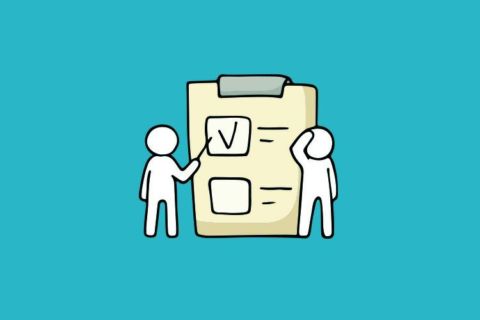Table of contents
Why start with a stakeholder interview?
5 steps to prepare for a successful stakeholder interview
- Identify your research goals
- Identify the stakeholders
- Define a timeline and budget
- Define the setup
- Send an email to your interviewees beforehand
How do you structure a stakeholder interview?
Stakeholder interviews in guerilla mode
- Use the prep email to ask generic questions
- Remote interviews via video call
- Asynchronous interviews via email
The ultimate checklist for conducting a stakeholder interview
The start of a new project is always a very exciting time: this is when you get to understand the product or service you are working on, its requirements and constraints. It is also during this early stage of the project that you will get to know who you are designing for as well as the business and persons behind the product or service. This is why conducting a stakeholder interview during this discovery phase is essential for the future of the design process.
A stakeholder interview consists of a one-on-one, semi-structured interview. In order to get optimal results, make sure to talk to all of your project stakeholders. If this isn’t possible, at least meet with a representative of each stakeholder group.
Why start with a stakeholder interview?
Sometimes, you might be lucky enough to work on a project within a field you know well. But usually, you will not know much about the product’s environment. Not only can your stakeholders provide you and your team with insights, but they are also likely to be involved in the decision process in the future.
Keeping their goals and constraints in mind will also make it easier to communicate your research results when the time comes. A stakeholder interview gives you the opportunity to lay the foundation for open lines of communication and to build trust, allowing you and your client to work in synergy.
While your stakeholders are likely domain or product experts, you may or may not be. But you are the one who will be able to identify users’ pain points and goals. You will understand the users in a way your stakeholders likely won’t.
In fact, stakeholders, like users, may not be aware of the prejudices they have about users and the problems they encounter. Being able to point out a mismatch between assumptions and reality will save a lot of time and money further down the line.

Stakeholders’ assumptions about the user don’t necessarily reflect reality.
5 steps to prepare for a successful stakeholder interview
1. Identify your research goals
What do you want to find out? Even if you are running a semi-structured interview, it is best to prepare a guideline or script to identify a few important questions you need answers to. Make sure to go beyond the project requirements: as with any user interview, you want to hear about the stakeholders’ pains and motivations, not just about the business plan. Also, experts tend to assume that what is obvious to them is obvious to all. Make sure you familiarise yourself with the full scope of the project.
2. Identify the stakeholders
Depending on the project you are working on, the stakeholders may be on different levels of an organisation: management, engineering, marketing and communication, sales, technical support, etc. Every single person whose job will be affected by the product is a stakeholder. Once you have written up a list of the stakeholders, you will want to group them by level, activity or involvement in the project. If you can clearly identify different groups of stakeholders, you will want to have a different set of questions for each specific group. For example, people in management might be less sensitive to technological limitations, while the engineering team might not be aware of the constraints caused by the market or competitors.
3. Define a timeline and a budget
When working on smaller projects or with a limited budget, time may become a huge limitation. However, do not try to save time by cutting the stakeholder interview phase short. Plan ahead and make sure you allocated enough time to each interview as well as to breaks in between to gather your insights. If you are limited by time, location and/or budget, you might want to conduct your stakeholder interviews in “guerilla mode,” which I will talk more about later.
4. Define the setup
Whatever method you choose to run the stakeholder interview, make sure to have all the necessary equipment when you need it. If possible, work as a team in this research phase: one person conducts the interview while the other one observes and takes notes. If this ideal setup is not possible, you can easily record the interview, as long as the interviewee has been informed and has explicitly agreed to it.
Should you conduct a remote interview, make sure to plan enough time (ideally at least 45-60 minutes) and to test your software before the actual interview. Your connection should be stable, you shouldn’t have any interferences of any kind and the sound should be clear. Make sure you allow your interviewees to use tools they are familiar with. Alternatively, if you provide a new tool, guide them through the setup process, adding extra time ahead of the interview slot as needed.
5. Send an email to your interviewees beforehand
This is just as important as the content of the interview itself. Keep in mind that you are not necessarily dealing with people familiar with this kind of research. They might have several questions. Make sure to explain that the content of the interview will in no way be used to assess them, their professionalism or their knowledge. Present the context and the scope of the interview and inform them ahead of time so they know what is coming up. There is nothing worse than an interviewee feeling caught by surprise, possibly misunderstanding the purpose of the interview.
Leave space for questions and take time to answer them. Define the time you will require from them and respect it. Should you, during the interview, realise that more time will be required, kindly ask whether the interviewee would mind extending the planned slot or whether he or she would mind scheduling a new slot to continue the discussion.
When reviewing the goals and scope of the interview, make sure to include a few keywords to guide the interviewee through the questions (we will first have a look at this, then at that,…).
How do you structure a stakeholder interview?
1. Start with an icebreaker

Start with an icebreaker. Like this fat penguin.
First things first: start with an icebreaker. It seems odd to point this out, but it is a common and understandable mistake, particularly when you are pressed for time. As we have seen before, you first sent an email and maybe used this opportunity to ask a few generic questions about the interviewee. This is an excellent subject to start with. As some time might have passed since the interviewee answered your email, make sure to touch base first. Thanking them for their time and summing up their answers in a few words shows your interviewee that you appreciate the effort and gives them some time and space to prepare for the next questions.
Make sure to recap the goal of the interview in a few words before getting to the schedule. Also, make sure you have as much time available as originally planned. Should you choose to record the interview, this is an excellent moment to get the interviewee’s approval. This should not take much time but make sure to go through all these points to avoid any bad surprises. A script, check-list or interview guide may be very useful to make sure nothing gets forgotten.
2. Get to the core of the subject
Each project and product requires specific questions and answers but you should structure your interview in as many sections as you want to find out about. For example, your stakeholders’
- field of expertise and their tasks within the organisation
- target audience
- own needs, motivation and goals
- competition or market
- constraints that might somehow be in the project or the team’s way
Going through this, observe whether or not their needs are aligned with the vision expressed in the requirements documentation. Are there undisclosed needs you should know about? It is also essential to find out if any research materials have been issued previously. These would allow you to save precious time and resources.
UX apprentice provides a fairly well-structured template which can be used as a cheat sheet. However, you need to adapt the structure and content of your interview to your project and to the stakeholders you are dealing with.
3. Keep the lines of communication open
When approaching the end of your interview, make sure to reserve some time for questions your interviewee may have. The whole process may have piqued their interest in the research.
Even if some of them might have shown some doubts about the exercise at first, you would be surprised how many people love talking about their jobs, concerns, needs and maybe even fears about a project. Each of your stakeholders will take precious time and energy to provide you with useful insights. Be thankful and show your appreciation for this. Not only will this help to establish trust for the future, but it will also help you build a connection for the future. In my experience, many stakeholders show a lot of interest in the future of the project and ask to be kept up-to-date about the following steps. This is an excellent sign. Why not initiate this yourself by offering to keep them in the loop? You might want to use some of your stakeholders for further research with a focus group, for example.
Stakeholder interviews in guerilla mode

You don’t have to be Rambo to interview in guerilla mode.
For the record: guerilla means quick, but not dirty! In an ideal world, you would have plenty of time and highly flexible stakeholders. The reality of most companies and of tight agile sprints is often not that ideal. This should not prevent you from conducting your stakeholder interview. Skipping this step is simply not an option. If you are running out of time or are working on a very tight budget, the “guerilla mode” offers you the opportunity to gain quick insights with little investment. The success of this approach, though, relies completely on excellent and correct planning.
Depending on your time and budget, you may want to apply a mixed approach or go all guerilla. A few methods that have proven to work very well for me are the following:
Use the prep email to ask generic questions
Prepping your interviewees is a crucial step of the stakeholder interview, guerilla mode or no. A good prep consists of setting the stage for the coming interview, defining the goal, the scope and the frame of the interview. Some stakeholders will have been instructed to help you by their managers, which puts them in the uncomfortable situation of having no other option than to accept your invitation. So make sure you are very clear about the goal of the interview: this is not an assessment. Their expertise is required and not their ability to solve a problem.
Next, move on to the usual pieces of information (time, location, length, contact details, accessibility by public transport or parking availability, etc.). Use your prep email to ask a few generic questions that are common to all stakeholders and can easily be transcribed in written form.
As we saw before, if you happen to be limited by time or budget, you can use the prep email to ask generic questions that do not necessarily require your presence as an observer or mediator.
Examples:
- Define your role within the company.
- Define your role within the project.
- Who are the typical users of this product?
- Who are your main competitors?
These questions offer you the opportunity to gather important knowledge about your interviewee. They will help you to establish contact more quickly during the actual interview. Are you running on a very tight time budget? You may want to dig a bit deeper (keeping in mind that you can go into detail in the one-on-one interviews):
- How will this project impact your job?
- How would you measure whether or not this project is a success?
- Where do you see the main constraints or difficulties?
It is up to you to define which questions are suitable to be answered via email and which must be discussed during the interview. Make sure you start the conversation with a summary of the answers you got via email (I understand your role is… and you define the success of this project as…), establishing connections and showing your appreciation for the time they put into this pre-work. Then move on to the other questions in your script which require more time to discuss.
Remote interviews via video call
Not enough time or budget to meet the stakeholders in person? No problem. Rather than an in-person meeting, set up a remote interview. Any video call tool will do, as long as you respect a few key criteria:
- Make sure you have an excellent connection. A low-performing tool, a weak connection or bad sound quality will ruin a remote interview.
- Pick a tool your interviewees will feel comfortable using. No need to go for a fancy solution if they will struggle to use it.
- If the tool needs to be installed (plug-in, application), make sure you send detailed instructions in your prep email.
- Pick a proper location and time slot to run the interview. A quiet environment where you will not be disturbed is ideal. You should be able to dedicate yourself to the interviewee the whole time.
- Pre-test the tool with a colleague before starting with the first interview to avoid any technical problems.
- The icing on the cake is getting an additional person to observe the interview and to take notes.
Asynchronous interviews via email
In the most tricky situations, where your stakeholders cannot make it to a remote interview (maybe due to a different time zone), another way to get your answer would be to run the interview asynchronously via email. This method contains some obvious disadvantages, such as a lack of spontaneity and not being able to see your interviewee’s expressions and gestures. But it also has some advantages: introverted people, for example, often feel more comfortable writing rather than talking to an interviewer.
The success of this method relies mainly on the quality of your script and your ability to ask follow-up questions to expand on interesting topics. Feel like you are missing too many details only a real conversation can provide? Try to complete the email interview with a phone call at a convenient time for your interviewee. This is far from ideal but still better than no interview at all.
The ultimate checklist for conducting a stakeholder interview

At this point, you should have the knowledge you need to be able to run a successful stakeholder interview. But every project comes with its own specifications and constraints. So it is very important to adapt the methodology to your research goals and to your stakeholders. Use this checklist to help you:
Do
- plan at least 45 minutes for each interview.
- brief the stakeholder with a short email ahead of the actual interview.
- dig deeper than the requirement brief.
- lay the foundation for open lines of communication in the future.
- be aware of discordances between different stakeholders.
- consider assumptions regarding the users and their needs.
- be open for fears or scepticism towards your approach: this is your chance to establish trust.
- be clear about your research goals: what do you want to learn?
- prepare your script accordingly.
- test it with a third person (not a stakeholder).
Don’t
- forget to consider all possible stakeholders.
- focus on solutions, features, or problems you may have identified. Be genuinely curious and really listen to each stakeholder’s concerns.
- try to confirm your own assumptions at this point of the research process: you are in the discovery phase.
- get messy with the preparation: good prep is the key to success.

